Martin Atzmueller
ProtoMask: Segmentation-Guided Prototype Learning
Oct 01, 2025Abstract:XAI gained considerable importance in recent years. Methods based on prototypical case-based reasoning have shown a promising improvement in explainability. However, these methods typically rely on additional post-hoc saliency techniques to explain the semantics of learned prototypes. Multiple critiques have been raised about the reliability and quality of such techniques. For this reason, we study the use of prominent image segmentation foundation models to improve the truthfulness of the mapping between embedding and input space. We aim to restrict the computation area of the saliency map to a predefined semantic image patch to reduce the uncertainty of such visualizations. To perceive the information of an entire image, we use the bounding box from each generated segmentation mask to crop the image. Each mask results in an individual input in our novel model architecture named ProtoMask. We conduct experiments on three popular fine-grained classification datasets with a wide set of metrics, providing a detailed overview on explainability characteristics. The comparison with other popular models demonstrates competitive performance and unique explainability features of our model. https://github.com/uos-sis/quanproto
Kriging prior Regression: A Case for Kriging-Based Spatial Features with TabPFN in Soil Mapping
Sep 11, 2025Abstract:Machine learning and geostatistics are two fundamentally different frameworks for predicting and spatially mapping soil properties. Geostatistics leverages the spatial structure of soil properties, while machine learning captures the relationship between available environmental features and soil properties. We propose a hybrid framework that enriches ML with spatial context through engineering of 'spatial lag' features from ordinary kriging. We call this approach 'kriging prior regression' (KpR), as it follows the inverse logic of regression kriging. To evaluate this approach, we assessed both the point and probabilistic prediction performance of KpR, using the TabPFN model across six fieldscale datasets from LimeSoDa. These datasets included soil organic carbon, clay content, and pH, along with features derived from remote sensing and in-situ proximal soil sensing. KpR with TabPFN demonstrated reliable uncertainty estimates and more accurate predictions in comparison to several other spatial techniques (e.g., regression/residual kriging with TabPFN), as well as to established non-spatial machine learning algorithms (e.g., random forest). Most notably, it significantly improved the average R2 by around 30% compared to machine learning algorithms without spatial context. This improvement was due to the strong prediction performance of the TabPFN algorithm itself and the complementary spatial information provided by KpR features. TabPFN is particularly effective for prediction tasks with small sample sizes, common in precision agriculture, whereas KpR can compensate for weak relationships between sensing features and soil properties when proximal soil sensing data are limited. Hence, we conclude that KpR with TabPFN is a very robust and versatile modelling framework for digital soil mapping in precision agriculture.
Modern Neural Networks for Small Tabular Datasets: The New Default for Field-Scale Digital Soil Mapping?
Aug 13, 2025Abstract:In the field of pedometrics, tabular machine learning is the predominant method for predicting soil properties from remote and proximal soil sensing data, forming a central component of digital soil mapping. At the field-scale, this predictive soil modeling (PSM) task is typically constrained by small training sample sizes and high feature-to-sample ratios in soil spectroscopy. Traditionally, these conditions have proven challenging for conventional deep learning methods. Classical machine learning algorithms, particularly tree-based models like Random Forest and linear models such as Partial Least Squares Regression, have long been the default choice for field-scale PSM. Recent advances in artificial neural networks (ANN) for tabular data challenge this view, yet their suitability for field-scale PSM has not been proven. We introduce a comprehensive benchmark that evaluates state-of-the-art ANN architectures, including the latest multilayer perceptron (MLP)-based models (TabM, RealMLP), attention-based transformer variants (FT-Transformer, ExcelFormer, T2G-Former, AMFormer), retrieval-augmented approaches (TabR, ModernNCA), and an in-context learning foundation model (TabPFN). Our evaluation encompasses 31 field- and farm-scale datasets containing 30 to 460 samples and three critical soil properties: soil organic matter or soil organic carbon, pH, and clay content. Our results reveal that modern ANNs consistently outperform classical methods on the majority of tasks, demonstrating that deep learning has matured sufficiently to overcome the long-standing dominance of classical machine learning for PSM. Notably, TabPFN delivers the strongest overall performance, showing robustness across varying conditions. We therefore recommend the adoption of modern ANNs for field-scale PSM and propose TabPFN as the new default choice in the toolkit of every pedometrician.
Acting and Planning with Hierarchical Operational Models on a Mobile Robot: A Study with RAE+UPOM
Jul 15, 2025Abstract:Robotic task execution faces challenges due to the inconsistency between symbolic planner models and the rich control structures actually running on the robot. In this paper, we present the first physical deployment of an integrated actor-planner system that shares hierarchical operational models for both acting and planning, interleaving the Reactive Acting Engine (RAE) with an anytime UCT-like Monte Carlo planner (UPOM). We implement RAE+UPOM on a mobile manipulator in a real-world deployment for an object collection task. Our experiments demonstrate robust task execution under action failures and sensor noise, and provide empirical insights into the interleaved acting-and-planning decision making process.
Comprehensive Evaluation of Prototype Neural Networks
Jul 09, 2025Abstract:Prototype models are an important method for explainable artificial intelligence (XAI) and interpretable machine learning. In this paper, we perform an in-depth analysis of a set of prominent prototype models including ProtoPNet, ProtoPool and PIPNet. For their assessment, we apply a comprehensive set of metrics. In addition to applying standard metrics from literature, we propose several new metrics to further complement the analysis of model interpretability. In our experimentation, we apply the set of prototype models on a diverse set of datasets including fine-grained classification, Non-IID settings and multi-label classification to further contrast the performance. Furthermore, we also provide our code as an open-source library, which facilitates simple application of the metrics itself, as well as extensibility - providing the option for easily adding new metrics and models. https://github.com/uos-sis/quanproto
PHEATPRUNER: Interpretable Data-centric Feature Selection for Multivariate Time Series Classification through Persistent Homology
Apr 25, 2025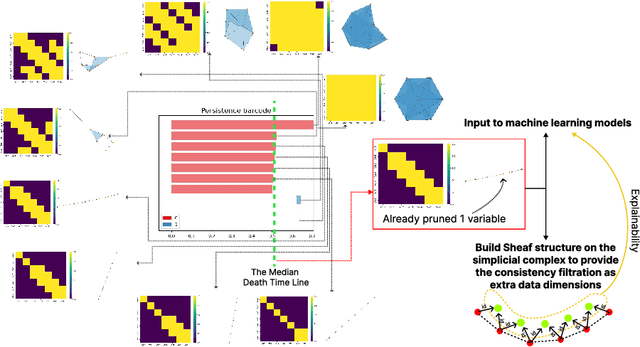
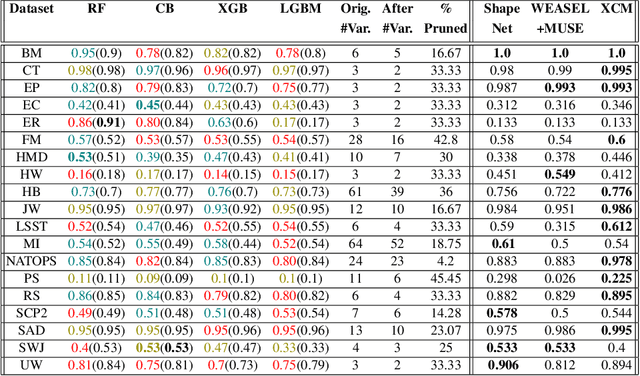
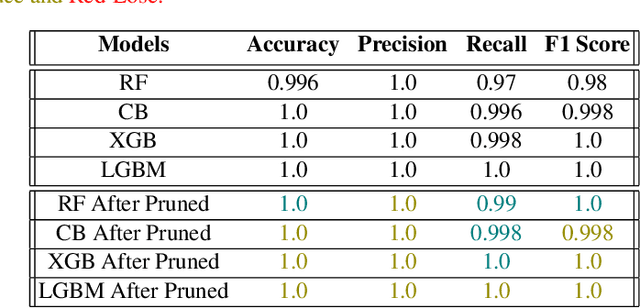
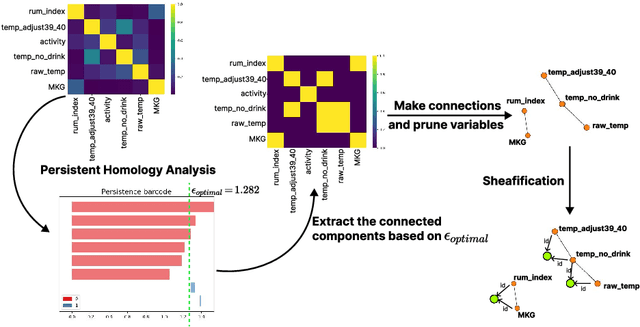
Abstract:Balancing performance and interpretability in multivariate time series classification is a significant challenge due to data complexity and high dimensionality. This paper introduces PHeatPruner, a method integrating persistent homology and sheaf theory to address these challenges. Persistent homology facilitates the pruning of up to 45% of the applied variables while maintaining or enhancing the accuracy of models such as Random Forest, CatBoost, XGBoost, and LightGBM, all without depending on posterior probabilities or supervised optimization algorithms. Concurrently, sheaf theory contributes explanatory vectors that provide deeper insights into the data's structural nuances. The approach was validated using the UEA Archive and a mastitis detection dataset for dairy cows. The results demonstrate that PHeatPruner effectively preserves model accuracy. Furthermore, our results highlight PHeatPruner's key features, i.e. simplifying complex data and offering actionable insights without increasing processing time or complexity. This method bridges the gap between complexity reduction and interpretability, suggesting promising applications in various fields.
Saliency Maps are Ambiguous: Analysis of Logical Relations on First and Second Order Attributions
Jan 23, 2025
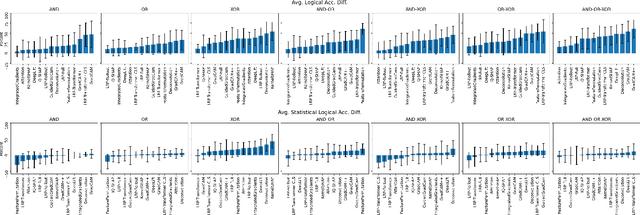


Abstract:Recent work uncovered potential flaws in \eg attribution or heatmap based saliency methods. A typical flaw is a confirmations bias, where the scores are compared to human expectation. Since measuring the quality of saliency methods is hard due to missing ground truth model reasoning, finding general limitations is also hard. This is further complicated, because masking-based evaluation on complex data can easily introduce a bias, as most methods cannot fully ignore inputs. In this work, we extend our previous analysis on the logical dataset framework ANDOR, where we showed that all analysed saliency methods fail to grasp all needed classification information for all possible scenarios. Specifically, this paper extends our previous work using analysis on more datasets, in order to better understand in which scenarios the saliency methods fail. Further, we apply the Global Coherence Representation as an additional evaluation method in order to enable actual input omission.
Saliency Methods are Encoders: Analysing Logical Relations Towards Interpretation
Dec 17, 2024
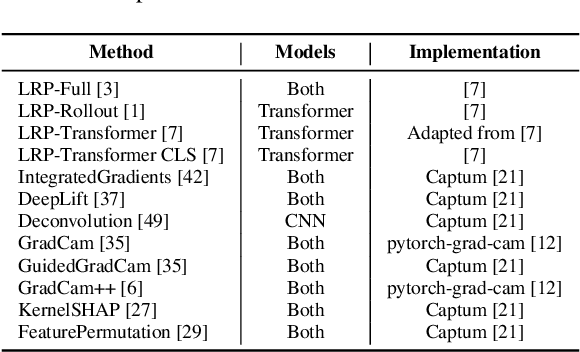


Abstract:With their increase in performance, neural network architectures also become more complex, necessitating explainability. Therefore, many new and improved methods are currently emerging, which often generate so-called saliency maps in order to improve interpretability. Those methods are often evaluated by visual expectations, yet this typically leads towards a confirmation bias. Due to a lack of a general metric for explanation quality, non-accessible ground truth data about the model's reasoning and the large amount of involved assumptions, multiple works claim to find flaws in those methods. However, this often leads to unfair comparison metrics. Additionally, the complexity of most datasets (mostly images or text) is often so high, that approximating all possible explanations is not feasible. For those reasons, this paper introduces a test for saliency map evaluation: proposing controlled experiments based on all possible model reasonings over multiple simple logical datasets. Using the contained logical relationships, we aim to understand how different saliency methods treat information in different class discriminative scenarios (e.g. via complementary and redundant information). By introducing multiple new metrics, we analyse propositional logical patterns towards a non-informative attribution score baseline to find deviations of typical expectations. Our results show that saliency methods can encode classification relevant information into the ordering of saliency scores.
Knowledge-Augmented Explainable and Interpretable Learning for Anomaly Detection and Diagnosis
Nov 28, 2024Abstract:Knowledge-augmented learning enables the combination of knowledge-based and data-driven approaches. For anomaly detection and diagnosis, understandability is typically an important factor, especially in high-risk areas. Therefore, explainability and interpretability are also major criteria in such contexts. This chapter focuses on knowledge-augmented explainable and interpretable learning to enhance understandability, transparency and ultimately computational sensemaking. We exemplify different approaches and methods in the domains of anomaly detection and diagnosis - from comparatively simple interpretable methods towards more advanced neuro-symbolic approaches.
Online Knowledge Integration for 3D Semantic Mapping: A Survey
Nov 27, 2024Abstract:Semantic mapping is a key component of robots operating in and interacting with objects in structured environments. Traditionally, geometric and knowledge representations within a semantic map have only been loosely integrated. However, recent advances in deep learning now allow full integration of prior knowledge, represented as knowledge graphs or language concepts, into sensor data processing and semantic mapping pipelines. Semantic scene graphs and language models enable modern semantic mapping approaches to incorporate graph-based prior knowledge or to leverage the rich information in human language both during and after the mapping process. This has sparked substantial advances in semantic mapping, leading to previously impossible novel applications. This survey reviews these recent developments comprehensively, with a focus on online integration of knowledge into semantic mapping. We specifically focus on methods using semantic scene graphs for integrating symbolic prior knowledge and language models for respective capture of implicit common-sense knowledge and natural language concepts
 Add to Chrome
Add to Chrome Add to Firefox
Add to Firefox Add to Edge
Add to Edge